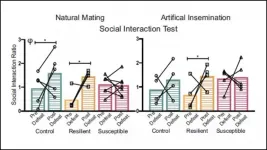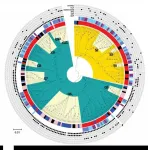(Press-News.org) A new study from researchers at Johns Hopkins Bloomberg School of Public Health and colleagues suggests a slowdown in the use of convalescent plasma to treat hospitalized COVID-19 patients led to a higher COVID-19 mortality during a critical period during this past winter's surge.
U.S. hospitals began treating COVID-19 patients with convalescent plasma therapy--which uses antibody-rich blood from recovered COVID-19 patients--in the summer of 2020 when doctors were looking to identify treatments for the emerging disease. By the spring of 2021, doctors in the United States had treated over 500,000 COVID-19 patients with convalescent plasma. The use of convalescent plasma started declining late in 2020 after several large clinical trials showed no apparent benefit.
The researchers' analysis suggests that the decline in convalescent plasma use might have led to more than 29,000 excess COVID-19 deaths from November 2020 to February 2021.
The study was published online June 4 in the journal eLife.
"Clinical trials of convalescent plasma use in COVID-19 have had mixed results, but other studies, including this one, have been consistent with the idea that it does reduce mortality," says study senior author Arturo Casadevall, MD, PhD, Alfred and Jill Sommer Professor and Chair of the Department of the Molecular Microbiology and Immunology at the Bloomberg School.
The study was done in collaboration with researchers at Michigan State University and the Mayo Clinic. Casadevall and colleagues observed that while plasma use was declining late last year, the reported COVID-19 patient mortality rate was rising. That led them to hypothesize that the two phenomena were related.
In the study, the researchers compared the number of units of plasma distributed to U.S. hospitals from blood banks, on a per patient basis, to the number of reported COVID-19 deaths per hospital admission across the country.
One finding was that while the total use of plasma peaked last December and January during the winter surge in new COVID-19 patients, the use per hospitalized patient peaked in early October 2020--just as deaths per COVID-19 hospital admission bottomed. Thereafter, in the wake of reports of negative results from clinical trials, use of plasma per hospitalized patient fell sharply--and deaths per COVID-19 hospital admission rose.
The researchers analyzed the relationship between these two datasets and found a strong negative correlation, higher use rate being associated with lower mortality and vice versa. They also grouped periods of plasma use into five "quintile" groupings from lowest-use weeks to highest, and found a graded relationship between less use and higher mortality.
A model the researchers generated to fit the data suggested that the COVID-19 case fatality rate decreased by 1.8 percentage points for every 10-percentage point increase in the rate of plasma use. That model implied that there would have been 29,018 fewer deaths, from November 2020 to February 2021, if the peak use rate of early October had held. Moreover, it suggested that the use of plasma on the whole, as limited as it was, prevented about 95,000 deaths through early March of this year.
The researchers analyzed, and then rejected, the possibility that several other factors could explain away the link between less plasma use and more mortality. These factors included changes in the average age of hospitalized patients, and the emergence of new variants of the COVID-19-causing coronavirus.
As for why some clinical trials found no benefit for plasma use, the researchers note in their paper that many of the clinical trials with negative results had used plasma--mainly considered an antiviral treatment--relatively late in the course of COVID-19, when patients may have been too ill to benefit, and when the disease is driven mainly by immune-related responses rather than the coronavirus itself.
Casadevall notes that convalescent plasma remains under FDA Emergent Use Authorization in the U.S., and that it is readily available. "We hope that physicians, policymakers, and regulators will consider the totality of the available evidence, including our findings, when making decisions about convalescent plasma use in individual COVID-19 patients," Casadevall says.
INFORMATION:
"Convalescent Plasma Use in the United States was inversely correlated with COVID-19 Mortality" was co-authored by Arturo Casadevall, Quigly Dragotakes, Patrick Johnson, Jonathon Senefeld, Stephen Klassen, R. Scott Wright, Michael Joyner, Nigel Paneth, and Rickey Carter.
There was no specific funding for this study. Individual authors have been supported by the National Institutes of Health (RO1 HL059842; R01 AI152078 9; 5R35HL139854).This project has been funded in whole or in part by the Department of Health and Human Services; Office of the Assistant Secretary for Preparedness and Response; Biomedical Advanced Research and Development Authority under Contract No. 75A50120C00096.
Male mice more susceptible to stress can pass down their behaviors to offspring via changes in their sperm's genetic code, according to new research published in JNeurosci.
Stressful experiences alter gene expression, which parents can pass down to their offspring. But it was unclear if sperm itself transmits this information, or if behavioral cues between the parents play a larger role.
Cunningham et al. tracked the stress response of male mice after ten days of chronic stress and sorted them into resilient and susceptible groups, based on the severity of their response. The offspring of resilient and control mice showed decreased stress behaviors ...
Researchers at the University of Sydney's Charles Perkins Centre conducted the largest ever study of nutrient interactions by examining the health of mice on 33 different diets containing various combinations of protein to carbs, and different sources of carbohydrate.
They found that a low-protein (10% of dietary energy), high-carbohydrate (70%) diet produced either the healthiest or unhealthiest metabolic outcomes of all 33 diets, depending on the kind of carbs.
When carbs were made up mainly of resistant starch, a form of starch that is resistant to digestion and is fermented by bacteria in the gut, the low protein diet was the healthiest of all diets. When the ...
A study examining gender bias and family-owned businesses found daughters were rarely encouraged nor received support to pursue entrepreneurship education while sons mostly did.
Professors James Combs, Peter Jaskiewicz, and Sabine Raul from the Telfer School of Management uncovered new insights about how gender bias - the preference of a gender over the other - affects the succession strategy in multi-generational family firms. Their findings are published in the Journal of Small Business Management.
When nurturing the next generation, entrepreneurial families often prepare their daughters and sons differently for their careers. The researchers noticed a common pattern in the stories shared by the next generation: Sons are often nurtured to ...
It's hard to see more than a handful of stars from Princeton University, because the lights from New York City, Princeton and Philadelphia prevent our sky from ever getting pitch black, but stargazers who get into more rural areas can see hundreds of naked-eye stars -- and a few smudgy objects, too.
The biggest smudge is the Milky Way itself, the billions of stars that make up our spiral galaxy, which we see edge-on. The smaller smudges don't mean that you need glasses, but that you're seeing tightly packed groups of stars. One of the best-known of these "clouds" or "clusters" -- groups of stars that travel together -- is the Pleiades, also known as the Seven Sisters. Clusters are stellar nurseries where thousands of stars are born from clouds of gas and dust and then ...
COLUMBUS, Ohio - Researchers have discovered a new electronic property at the frontier between the thermal and quantum sciences in a specially engineered metal alloy - and in the process identified a promising material for future devices that could turn heat on and off with the application of a magnetic "switch."
In this material, electrons, which have a mass in vacuum and in most other materials, move like massless photons or light - an unexpected behavior, but a phenomenon theoretically predicted to exist here. The alloy was engineered with the elements bismuth and antimony at precise ranges based ...
Carbon dioxide emissions in Los Angeles fell 33% in April of 2020 compared with previous years, as roads emptied and economic activity slowed due to the COVID-19 pandemic, according to a new study in Geophysical Research Letters. In the Washington, D.C./Baltimore region, emissions of carbon dioxide, or CO2, dropped by 34% during the same period.
The study was led by scientists at NASA's Jet Propulsion Laboratory (JPL), the National Institute of Standards and Technology (NIST) and the University of Notre Dame.
While the emissions reductions are significant, the method that scientists used to measure them may have the greater long-term impact.
In both locations, scientists had previously ...
Research between the University of Liverpool, UK and National Tsing Hua University (NTHU), Taiwan has revealed a new charge storage mechanism that has the potential to allow rechargeability within calcium-air batteries.
In a paper published in the journal Chemical Science, Professor Laurence Hardwick from the University of Liverpool's Stephenson Institute for Renewable Energy (SIRE) and colleagues discover a distinctive form of charge storage at the electrode interface described as trapped interfacial redox. This new finding introduces a new mechanism of charge storage that could be harnessed in practical devices.
Lead author of the paper, Yi Ting (Leo) Lu, is a joint PhD student in ...
A new study at the University of Chicago has determined that restoring a single microbial species -- Bacteroides sp. CL1-UC (Bc) -- to the gut microbiome at a key developmental timepoint can prevent antibiotic-induced colitis in a mouse model of the condition. The results, published on June 7 in END ...
TROY, N.Y. -- More strategic and coordinated travel restrictions likely could have reduced the spread of COVID-19 in the early stages of the pandemic. That's according to new research published in Communications Physics. This finding stems from new modeling conducted by a multidisciplinary team of scientists and engineers at Rensselaer Polytechnic Institute.
The researchers evaluated the distance between countries in terms of air travel, a more complex measurement than simply mapping physical distance. For instance, while China and Thailand may be geographically more proximate to one another, if there are significantly ...
In young women, Staphylococcus saprophyticus is a main cause of urinary tract infections (UTI), reaching 20% prevalence. Understanding the epidemiology of this microorganism can help identify its origin, distribution, causes, and risk factors. Now, ITQB NOVA researchers led by Maria Miragaia showed evidence that Staphylococcus saprophyticus can originate in food, namely in the meat-production chain.
Europe is the world's second-biggest producer of pork, the most favored meat type in these countries. One of the contaminants of that meat is S. saprophyticus, which is found also in the environment, ...




